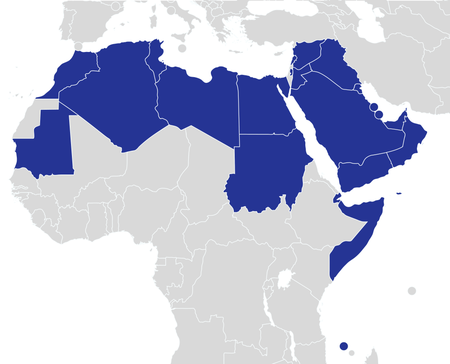Screening (economics)
|
Read other articles:

A historical river-side town in the Perak Upper District For the federal constituency represented in the Dewan Rakyat, see Pasir Salak (federal constituency). This article needs additional citations for verification. Please help improve this article by adding citations to reliable sources. Unsourced material may be challenged and removed.Find sources: Pasir Salak – news · newspapers · books · scholar · JSTOR (December 2009) (Learn how and when to remove t…

Peta Dunia Arab Dunia Arab (Arab: العالم العربي, Al-`Alam Al-`Arabi) merujuk pada negara-negara berbahasa Arab yang terbentang dari Samudra Atlantik di barat hingga Laut Arab di timur dan dari Laut Tengah di utara hingga Tanduk Afrika dan Samudra Hindia di tenggara. Dunia Arab terdiri dari 24 negara dan wilayah dengan populasi 325 juta jiwa dalam dua benua. Sentimen nasionalisme Arab muncul pada paruh kedua abad ke-19, bersamaan dengan lahirnya gerakan-gerakan nasionalis lainnya …

Use of two languages across a variety of educational subjects Language immersion, or simply immersion, is a technique used in bilingual language education in which two languages are used for instruction in a variety of topics, including math, science, or social studies. The languages used for instruction are referred to as the L1 and the L2 for each student, with L1 being the student's native language and L2 being the second language to be acquired through immersion programs and techniques. Ther…

本條目存在以下問題,請協助改善本條目或在討論頁針對議題發表看法。 此條目可能包含原创研究。 (2018年3月29日)请协助補充参考资料、添加相关内联标签和删除原创研究内容以改善这篇条目。详细情况请参见讨论页。 此條目需要补充更多来源。 (2010年2月4日)请协助補充多方面可靠来源以改善这篇条目,无法查证的内容可能會因為异议提出而被移除。致使用者:请搜索一下�…

若纳斯·萨文比Jonas Savimbi若纳斯·萨文比,摄于1990年出生(1934-08-03)1934年8月3日 葡屬西非比耶省Munhango(葡萄牙語:Munhango)逝世2002年2月22日(2002歲—02—22)(67歲) 安哥拉莫希科省卢库塞效命 安哥拉民族解放阵线 (1964–1966) 争取安哥拉彻底独立全国联盟 (1966–2002)服役年份1964 – 2002军衔将军参与战争安哥拉独立战争安哥拉內戰 若纳斯·马列罗·萨文比(Jonas Malheiro Savimbi,1934…

Pour le village bosniaque, voir Bandol (Travnik). Pour le vin, voir bandol (AOC). Bandol Bandol vue des calanques le soir en été. Héraldique Administration Pays France Région Provence-Alpes-Côte d’Azur Département Var Arrondissement Toulon Intercommunalité Communauté d'agglomération Sud Sainte Baume Maire Mandat Jean-Paul Joseph 2020-2026 Code postal 83150 Code commune 83009 Démographie Gentilé Bandolais Populationmunicipale 8 311 hab. (2021 ) Densité 969 hab./km2 G�…

باروكيةمعلومات عامةالبداية القرن 16[1] النهاية عقد 1750 المنطقة أوروبا — روسيا — العالم الجديد التأثيراتتفرع عنها القائمة ... Baroque literature (en) — Baroque art (en) — High Baroque (en) — Late Baroque (en) — Early Baroque (en) تأثرت بـ مجمع ترنت تكلفيةعصر النهضة تعديل - تعديل مصدري - تعديل ويكي بيانات تاريخ ا�…

هذه المقالة يتيمة إذ تصل إليها مقالات أخرى قليلة جدًا. فضلًا، ساعد بإضافة وصلة إليها في مقالات متعلقة بها. (يناير 2016) بنك جرينجوتسمعلومات عامةجزء من Diagon Alley (en) البلد الولايات المتحدة تقع في التقسيم الإداري أورلاندو المكان Diagon Alley (en) الإحداثيات 28°29′N 81°28′W / 28.48°N 81.47°W&#…

Mosque in Amol, Mazandaran, Iran Jāmeh Mosque of AmolReligionAffiliationShia IslamProvinceMazandaran ProvinceLocationLocationAmol, IranMunicipalityAmol CountyShown within IranGeographic coordinates38°04′52″N 46°17′25″E / 38.0810°N 46.2904°E / 38.0810; 46.2904ArchitectureTypeMosqueCompletedSafavid dynastyQajar dynasty The Jāmeh Mosque of Amol (Persian: مسجد جامع آمل – Masjid-e-Jāmeh Amol)[1] is the grand, congregational mosque (Jāmeh) o…

Australian railway line Central Coast & Newcastle LineA NSW TrainLink H set approaching Tascott stationOverviewService typeIntercity railLocaleCentral Coast and Newcastle, New South WalesCurrent operator(s)NSW TrainLinkRouteTerminiSydney CentralNewcastle InterchangeStops36Distance travelled165.60 km (102.90 mi)Line(s) usedMain North railway lineNewcastle railway lineTechnicalRolling stockNSW TrainLink H and V setsTrack gauge1,435 mm (4 ft 8+1⁄2 in) standar…

Правдивая история Красной Шапкиангл. Hoodwinked Жанры бадди-муви, детский фильм, фэнтезийный фильм и музыкальный фильм Техника анимации компьютерная Режиссёры Кори ЭдвардсТодд ЭдвардсТони Лич Авторы сценария Кори ЭдвардсТодд ЭдвардсТони Лич Роли озвучивали Глен�…

هذه المقالة عن الزهد يالمفهوم العام. لمعانٍ أخرى، طالع الزهد في الإسلام. الزهد[1][2][3] والتنسك[3][4] أو التقشف[3] هو مذهب أخلاقي يقوم على تحقير اللذة الحسية وممارسة الرياضات الروحية ابتغاء الكمال.[1] عرف الزهد مذهبًا في العديد من الديانات بما في�…

Motorsport venue in Trenton, New Jersey, United States Trenton Speedway The kidney bean shaped ovalLocationHamilton Township, Mercer County, near Trenton, New JerseyOwnerGeorge A. Hamid Jr.OpenedSeptember 24, 1900ClosedJune 29, 1980Former namesTrenton International SpeedwayMajor eventsAAA/USAC/CART Championship Car Trenton 100/150/200/300 (1949, 1957–1979)NASCAR Grand National/Winston Cup Northern 300 (1958–1959, 1967–1972)Half-mile oval (1900–1941)SurfaceDirtLength0.5 miles (.81 km)Mile…

Anticipations of feminism Part of a series onFeminism History Feminist history History of feminism Women's history American British Canadian German Waves First Second Third Fourth Timelines Women's suffrage Muslim countries US Other women's rights Women's suffrage by country Austria Australia Canada Colombia India Japan Kuwait Liechtenstein New Zealand Spain Second Republic Francoist Switzerland United Kingdom Cayman Islands Wales United States states Intersectional variants Fat Lesbian Lesbian …

Provinsi gerejawi Juba dengan wilayah Yei Keuskupan Yei (bahasa Latin: Yeien(sis)) adalah sebuah keuskupan yang terletak di kota Yei, provinsi gerejawi Juba, Sudan Selatan. Riwayat 21 Maret 1986: Didirikan sebagai Keuskupan Yei dari Keuskupan Rumbek. Pemimpin Uskup Yei (Ritus Roma) Uskup Erkolano Lodu Tombe (sejak 21 Maret 1986) Sumber GCatholic.org Diocese of Yei website Diarsipkan 2007-06-26 di Wayback Machine. lbsKeuskupan Gereja Katolik di Sudan SelatanProvinsi Gerejawi Juba Keuskupan Ag…

CrocodileEpisode Black MirrorPoster promosiNomor episodeEpisode 3SutradaraJohn HillcoatPenulisCharlie BrookerMusikOriginal Score byAtticus RossLeopold RossClaudia SarneTanggal siar29 Desember 2017 (2017-12-29)Durasi59 minutesBintang tamu Andrea Riseborough sebagai Mia Nolan Andrew Gower sebagai Rob Kiran Sonia Sawar sebagai Shazia Akhand Anthony Welsh sebagai Anan Akhand Claire Rushbrook sebagai detektif polisi Joshua James sebagai Gordy Adelle Leonce sebagai Noni Harper-Brown Brian Pettife…

Nicolò Barsanti Nicolò Barsanti, meglio conosciuto come Eugenio (Pietrasanta, 12 ottobre 1821 – Seraing, 18 aprile 1864), è stato un presbitero, ingegnere e inventore italiano, l'ideatore e costruttore del primo motore a combustione interna funzionante. Francobollo che ritrae Eugenio Barsanti e Felice Matteucci Indice 1 Biografia 2 Archivio 3 Note 4 Bibliografia 5 Altri progetti 6 Collegamenti esterni Biografia Nato nella parrocchia di San Martino in Pietrasanta come Gian Niccolò Barsanti,…

هذه المقالة يتيمة إذ تصل إليها مقالات أخرى قليلة جدًا. فضلًا، ساعد بإضافة وصلة إليها في مقالات متعلقة بها. (أبريل 2019) بلير كلارك معلومات شخصية الميلاد 22 أغسطس 1917 قرية إيست هامبتون الوفاة 6 يونيو 2000 (82 سنة) برينستون مواطنة الولايات المتحدة الحياة العملية المدر�…

City and county seat in Texas, United StatesCrystal City, TexasCity and county seatSacred Heart Catholic Church in Crystal CityNickname: Spinach Capital of the WorldLocation of Crystal City, TexasCoordinates: 28°41′4″N 99°49′40″W / 28.68444°N 99.82778°W / 28.68444; -99.82778CountryUnited StatesStateTexasCountyZavalaGovernment • MayorFrank Moreno Junior[1]Area[2] • Total3.65 sq mi (9.46 km2) •&#…

Aleksandar Aleksić Datos personalesNacimiento Šabac, Yugoslavia13 de abril de 1992 (32 años)Carrera deportivaRepresentante de Serbia SerbiaDeporte Piragüismo Medallero Piragüismo en aguas tranquilas masculino Evento O P B Campeonato Europeo 0 0 1 [editar datos en Wikidata] Aleksandar Aleksić –en serbio, Александар Алексић – (Šabac, 13 de abril de 1992) es un deporti…
